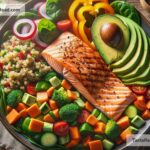The Benefits of a Low-Fat Diet: Tips and Tricks
Maintaining a healthy lifestyle is something many people strive for, but with so much advice out there, it can feel overwhelming. One approach that has proven effective for improving health is following a low-fat diet. This eating plan doesn’t mean you have to completely avoid fat; instead, it focuses on reducing unhealthy fats and choosing healthier options. In this blog post, we’ll explore the benefits of a low-fat diet and share tips and tricks to make it easy to follow.
What is a Low-Fat Diet?
A low-fat diet involves limiting your intake of fat, particularly saturated and trans fats, which can be harmful to your health. Fat is an essential part of our diet because it provides energy, helps absorb vitamins, and supports cell function. However, eating too much unhealthy fat can lead to problems like weight gain, heart disease, and high cholesterol. By eating less fat and opting for healthier fats, you can improve your overall health while still enjoying flavorful meals.
The Benefits of a Low-Fat Diet
-
Supports Heart Health
A diet high in saturated and trans fats can increase your cholesterol levels and raise your risk of heart disease and stroke. By choosing a low-fat diet, you can protect your heart. Foods like fruits, vegetables, whole grains, and lean proteins can help reduce bad cholesterol (LDL) and increase good cholesterol (HDL), creating a healthier balance. -
Helps Manage Weight
Fat contains more calories per gram (9 calories) than proteins or carbohydrates (4 calories each). This means that eating high-fat foods often leads to consuming more calories. By reducing fat intake, you can slide under your calorie goals and support your weight loss or management efforts. -
Improves Digestion
High-fat diets can sometimes overload your digestive system, making it harder for your body to break down food properly. Low-fat diets are typically rich in fiber because they emphasize fruits, vegetables, and whole grains. Fiber helps regulate digestion, prevents constipation, and promotes gut health. -
Boosts Energy
Heavy, greasy meals can make you feel sluggish. Maintaining a low-fat diet with lighter, nutrient-dense foods can give you steady energy throughout the day. This makes sticking to a healthy routine much easier. -
Reduces Disease Risks
Eating a diet with less fat can lower your risk of diseases tied to obesity, high cholesterol, and high blood pressure. Conditions like type 2 diabetes, certain cancers, and heart disease are less likely when you commit to healthier eating practices.
Tips and Tricks for Following a Low-Fat Diet
Switching to a low-fat diet doesn’t mean giving up all of your favorite foods or feeling deprived. With a few simple tips and tricks, you can enjoy delicious meals while taking care of your health.
1. Choose Healthy Fats
Not all fats are bad for you! Focus on eating healthy fats like those found in avocados, nuts, seeds, olives, and fatty fish like salmon. These fats are good for your heart and provide important nutrients.
- Cook with olive oil instead of butter.
- Sprinkle nuts or seeds on salads or yogurt for extra crunch and nutrition.
2. Embrace Lean Proteins
Swap out fatty meats like processed sausages and bacon for lean proteins. Some good options include chicken breast, turkey, fish, tofu, and beans.
- Trim visible fat from meats before cooking.
- Grill, bake, or steam your proteins instead of frying them.
3. Eat More Fruits and Vegetables
Fruits and vegetables are naturally low in fat and packed with vitamins, antioxidants, and fiber. They are your best friends on a low-fat diet.
- Snack on fresh fruits instead of cookies or chips.
- Add vegetables to sandwiches, pastas, soups, and stir-fries.
4. Read Food Labels
Processed foods often contain hidden fats, especially trans fats, which are harmful to your health. Reading food labels can help you avoid high-fat options when shopping.
- Look for products labeled “low-fat” or “fat-free.”
- Be cautious with snacks, baked goods, and ready-made meals, as they may contain unhealthy fats.
5. Watch Your Portions
Even healthy fats can add up if you consume too much. Practice portion control and measure ingredients to ensure you stay within a healthy range.
6. Cook at Home
Preparing meals at home lets you control the ingredients and avoid unnecessary fats. Use cooking methods like baking, steaming, boiling, or grilling instead of frying.
- Make your own salad dressings with olive oil and vinegar instead of buying creamy ones.
- Replace fatty spreads with avocado slices or hummus.
7. Experiment with Spices and Herbs
One concern people have about eating low-fat meals is worrying that their food will taste bland. The good news is that spices and herbs can add flavor without adding fat.
- Season meals with garlic, ginger, cinnamon, parsley, or chili flakes.
- Try experimenting with different spice blends for variety.
Start Small, Stay Consistent
Switching to a low-fat diet doesn’t have to be difficult, and it doesn’t require drastic changes overnight. Start by making small swaps, like replacing unhealthy snacks with fruit or cooking with lean proteins instead of fatty meats. Over time, these small steps build into sustainable habits.
Remember, a low-fat diet is just one part of maintaining a healthy life. Exercise, hydration, and managing stress are equally important for your well-being. But choosing to eat less fat, improve your food choices, and add nutritious alternatives can make a big difference in how you feel.
By embracing a low-fat diet, you’re giving your body the care it deserves. You’ll have more energy, a healthier heart, and reduced risks of diseases down the road. With the tips and tricks outlined above, you’ll find that eating low-fat meals can be easy, delicious, and empowering. Give it a try—you may be surprised at how enjoyable it can be!


